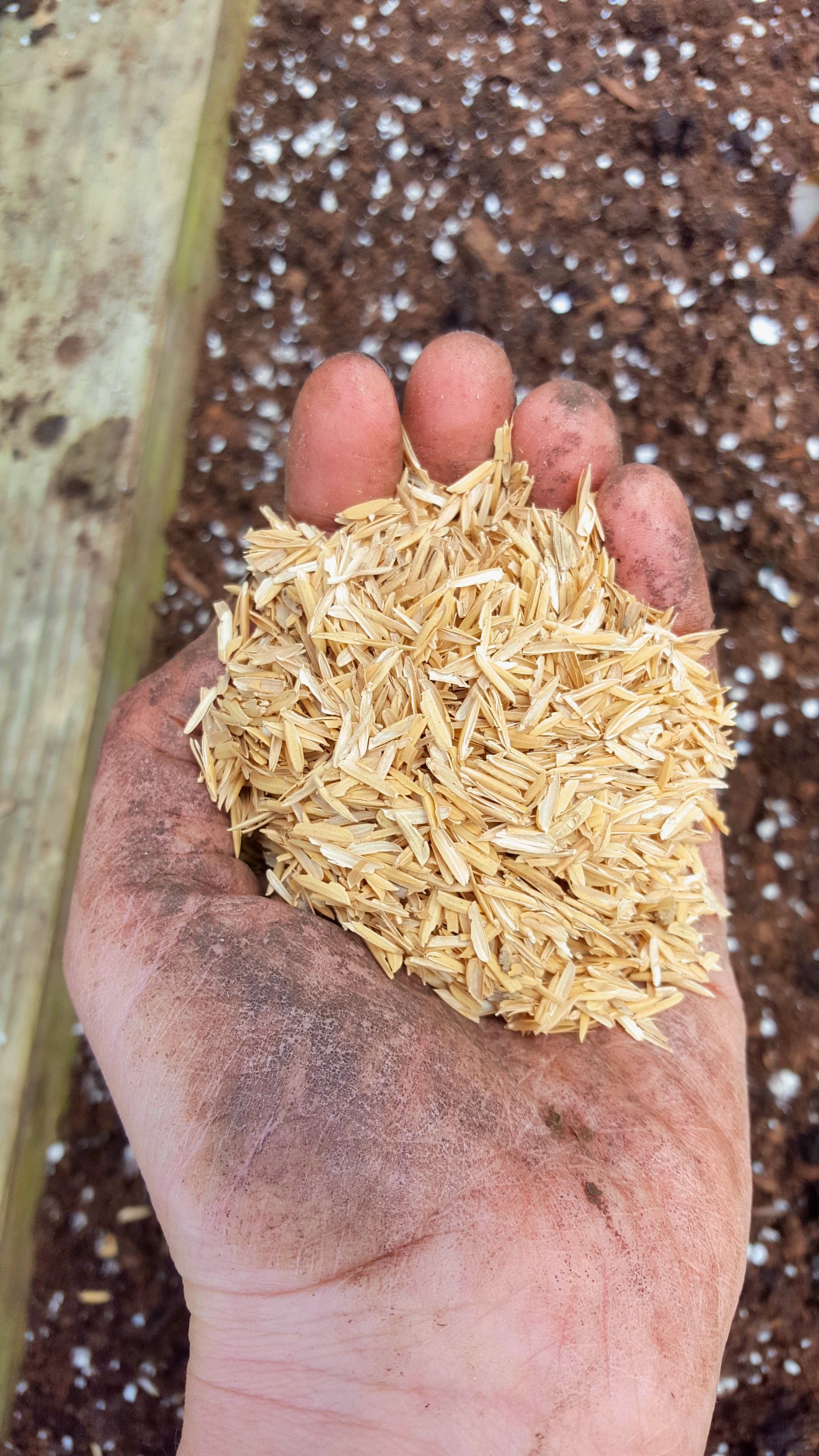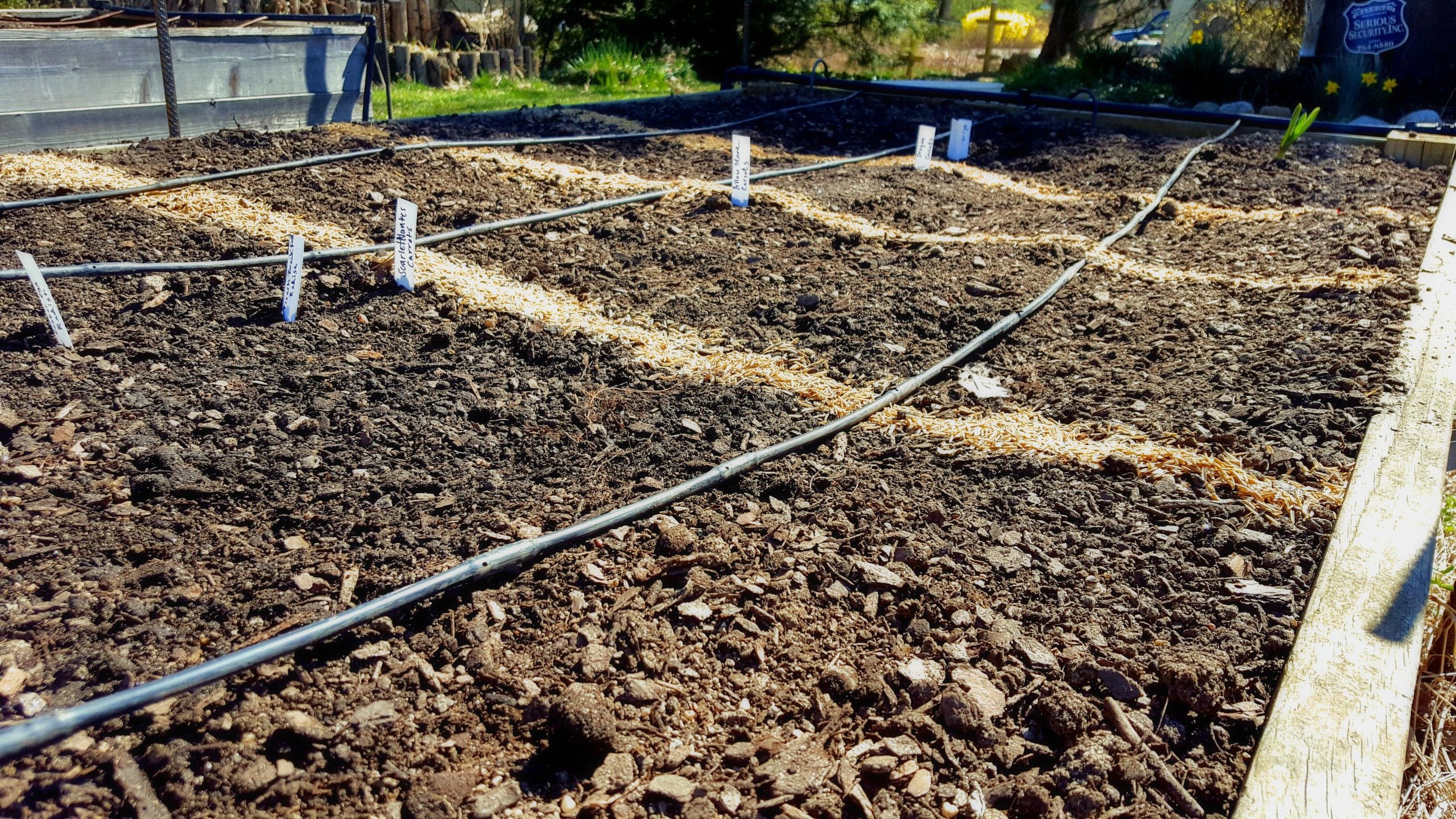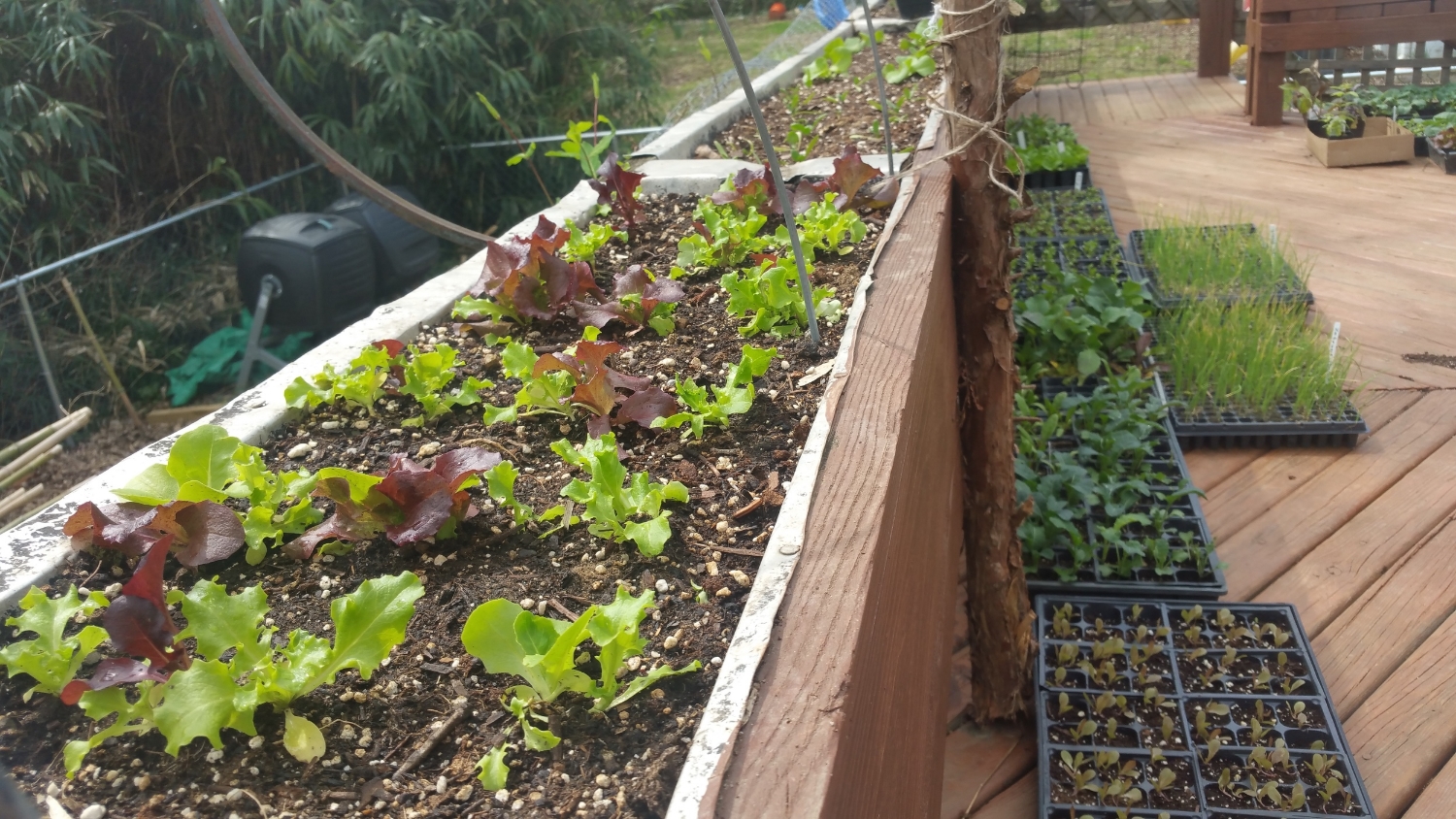As the largest native fruit in our region, Pawpaws are favorites in our edible landscaping. They can handle cold Winter temperatures and shady lighting, and they have relatively few pests.
Read moreRamping up for Spring
Ramps, or Wild Leeks, are wild edible plants in the allium family. Growing natively in the Appalachian mountains from Canada to North Carolina, ramps only appear for a few weeks before going to seed and disappearing for the Summer. As the first green to appear in early Spring, ramps have historically been celebrated as a sign of Spring and a tonic to the traditional Appalachian meat-heavy Winter diet.
Read moreRice Hulls
At Edible Eden, we spend a lot of time thinking about the larger impact of our work - we try to always choose the most responsible selection of plants, materials, and garden amendments that we can.
One eco-friendly material we love is rice hull! Rice hulls are the the husks around rice grains that are removed in processing. The hulls are then par-boiled to sterilize any rice grains and ensure no diseases are spread. We often use rice hulls to aerate, improve drainage, and retain water in our soils. Unlike the commonly used perlite and vermiculite, rice hulls are renewable resources. They do not have to be mined and no land is disrupted in their production: they would otherwise be considered a waste product! Unlike those other products, rice hulls are also organic material so they break down and add new nutrients to the soil over time. Because of this, you must refresh your beds with new hulls every year.
Rice hulls can also be used as a mulch much like straw or leaves. Use them to retain warmth or moisture in a bed or keep delicate seeds in place; we just topped our freshly planted carrot seeds with rice hulls to keep them from blowing away and provide good germinating conditions without burying them too deep.
Have you tried using rice hulls in your garden? Let us know what you think!
Fall Garden Tip
Fall Garden Tip
As the growing season comes to an end, here at Edible Eden we are putting the gardens in our care to bed for the winter. We start by pulling out all the spent (or mostly finished) crops. Plants that carry heavy disease loads like tomatoes and squash should not be put into the compost pile. Either let them decompose somewhere away from your garden, put them in with chickens or other livestock or even (sigh) put them in the garbage. There are just too many disease spores and pests that can contaminate your home compost.
Then we take down and store trellis materials, work compost into the beds, plant garlic, and cover it with straw mulch.
In some in-ground gardens we also sow cover crop seed. I tend to opt for cover crops for in-ground gardens as opposed to raised beds as I find it’s difficult to chop them up and till them in in a raised bed context in the spring time. Cover crops prevent more invasive weeds from taking root and some (like vetch or winter peas) will fix nitrogen in the soil, adding fertility for next spring. The trick is that you have to chop them up with a flail mower or scythe and till them into the soil a few weeks before planting if you are to get the most out of them.
A good place to start is with Austrian Winter Peas. While the pea itself is not edible, both the tender pea shoots and the flowers are delicious and an added benefit to using the plant as a cover crop.
You've Got Kale!
We are happy to share an article written by Farmer Josh was recently published in JMore magazine. Check out what he has to say about fall gardening!
DIY Lavender Vanilla Sugar Scrub!
DIY Lavender Vanilla Sugar Scrub
As much as we talk about growing healthy food for the body, we can also use the herbs and foods we grow for the skin. The herbs you grow in your garden - lavender, lemongrass, thyme - have fantastic relaxing and nourishing qualities that work well in skin care formulas.
There are endless possibilities in the world of home made beauty products, but here we’ll highlight just one, a personal favorite: the simple yet decadent Lavender Vanilla Sugar Scrub.
Mix together:
-¼ cup brown sugar
-¼ cup white sugar
-1.5 tbs oil (coconut, cocoa butter, sweet almond, olive oil, avocado oil are all good options)
-5-10 drops lavender essential oil
-¼ tsp vanilla extract
You can add additional exfoliants from your garden such as lavender leaves and seeds, borage, evening primrose, cleome flower seeds, and more!
Interested in making more natural beauty products? Try one of our Eco Spa classes at the Station North Tool Library, where we’ll make 3 different natural recipes for you to take home. Class schedule here: http://www.stationnorthtoollibrary.org/classes-1/
How to Plan Your Garden: Start Early!
I hope you are reading this somewhere cozy enjoying that delicious sensation of being warm and safe when it is cold and wintery outside. The past few days have finally brought what feels like real winter temperatures to the MidAtlantic region, the tender annuals are brown and dry, and thoughts of the garden’s fresh bounty seem distant.
One thing I love about a four-season climate is the opportunity to rest, reflect, recharge and plan between growing seasons. While we know that the old adage “make a plan and make god laugh” certainly holds true with any sort of farming or gardening, it’s also true that a garden plan can serve as a vital road map when navigating the fluctuations and challenges of a growing season.
Here at Edible Eden we create garden plans using Excel (although there are numerous aps and programs these days that purport to simplify the process). I like the Excel solution because it allows me to think strategically about the varieties, successions and rotations I want to include in my plan. Of course if your plan calls for a March 2 seeding of radishes and March 2 is a blizzard with frozen solid soil…obviously you will need to shift your timeline, but having the basic road map of how many of any given crop to plant where, on what date really helps maximize your yield because you an estimate how many successions you can fit into any given space.
One of the things I love about both landscape design and garden planning is that you are applying a blend of creativity and knowledge across a spectrum of dimensions- certainly time, space, height…but also temperature; remember that the same beet that claims 50 days until harvest in June will take a lot longer to reach maturity in the fall as the hours of sunlight wane and growth slows down (even if the temperatures stay warm).
That brings me to the question of timing. It would be fantastic if there was a hard and fast rule about any given element of garden timing. The truth is- especially in light of climate change- getting the timing right in your garden is like learning to dance on a moving carpet.
This past year I had all my tomato plants in the ground by the end of May and felt very proud of myself. And when the weather conditions conspired to welcome in heavy populations of fungal diseases and blight, most of my tomatoes died and I was very sad.
Meanwhile my wife, who cannot tolerate to see a plant die, had been nagging me to plant the left over tomato seedlings that were dying slowly on our deck all summer long- long past the point in the season that it isn’t worth planting. She just couldn’t stand to see them die; so against all my recriminations and judgements, finally she went and planted tomatoes all over the yard in late July…
Can you guess what happened? The late planting avoided the worst of the fungal diseases, and the warm weather lasted longer than usual…and we were picking ripe tomatoes for Thanksgiving dinner!
All this to say, the winter is a great time to plan, dream and prepare for the growing season even though you never know how the season will play out!
You most likely will want to order any seeds you are purchasing in January. And If you’d like
some help with your garden plan contact Edible Eden for a customized road map for your 2017 growing season.
What is Reemay? Every Farmer's Favorite Fabric
You may have seen it your neighborhood -- the spider webs, cackling pumpkins and plastic skeletons have been replaced by gourds and hand-traced turkeys taped to the window. October has come and gone, and Thanksgiving is quick on its heels. For gardeners nationwide, the next thirty days are a last breath of life before the winter freeze. Many are wondering how to get the most out of their edibles before it’s too late.
Here at Edible Eden, the start of November harkens the beginning of Reemay season. What is Reemay? Reemay is a type of cloth-like fabric, generally made of polyester or polypropylene, which can be stretched over just about any garden plant. The fabric lets in about 75% of all sunlight while helping the plant retain heat and ward off bugs. As the weather gets colder, Reemay is crucial for extending the life of your garden.
Reemay should be set up as soon as the weather starts to turn, we recommend getting it up as soon as possible! Leave it on through the New Year, by which point even a covering of Reemay won’t be enough to ward off the winter.
Reemay is perfect for any late fall crops, like cabbage, kale, arugula, spinach or carrots. By waiting as long as possible to harvest them, they grow sweeter. Reemay fabric can extend the life of your garden by several months and can result in plenty of extra pounds of produce. If you have even a couple of food plants in your garden, It makes sense to consider covering them for the next couple months.
To set up Reemay, we first stretch metal or PVC hoops over the garden to suspend the Reemay without crushing the plants. The fabric is anchored by garden staples pushed into the soil, or, if you’re on a budget, weighed down by rocks.
Interested in ensuring your fall harvest is as bountiful as possible? The garden gurus at Edible Eden can get your Reemay set up in an quick afternoon session. To learn more visit edibledenfoodscapes.com/contact.
Seasons of Abundance: Farm-to-Table Thanksgiving Ideas
Thanksgiving is such a confusing holiday! It’s simultaneously cozy and delicious and so hypocritical. There’s the historical injustice to consider and then there’s the factory farmed Butterball: monstrous animals so over-engineered they can’t even mate on their own. And yet, is there a better feast than the Thanksgiving shmorgasborg of autumnal abundance? Is there a meat more savory and delicious then a pasture-raised, heritage breed turkey roasted to perfection? Here in the MidAtlantic we can grow most of the components of a Thanksgiving feast right in our yards, and the holiday really gives us an opportunity to enjoy the bounty of our harvest! Here are some farm-to-table Thanksgiving ideas you can try this season.
This year we planted sweet potatoes in raised beds and they went nuts! Some tubers were big as my arm. Sweet potatoes, like winter squash, can be harvested, cured and held in a root cellar until their starring role in the big meal. If your sweet potatoes are visually perfect you will most likely candy roast them in chunks, but if the bugs have been nibbling them, never fear, just trim the ugly spots, boil the rest and make a mashed sweet potato casserole with brown sugar and pears (or marshmallows but you didn’t hear that part from me).
Hearty fall greens like kale and collards are still growing despite the mild frosts we have had so far. Those greens start getting sweeter and sweeter as the frost brings out the sugars. They are fantastic sautéed in olive oil and served with fried shallots and pumpkin seeds on top for a healthy side dish even the vegans will love.
Some other great farm-to-table Thanksgiving ideas: apples and pears have been ripening over the past few weeks and bring a wonderful crunch to any dish. Consider a ultra-local Thanksgiving salad incorporating arugula, red meat radish, honey crisp apple and purple onion. Don’t forget a rice pilaf with wild rice, baby carrots, onions and thinly sliced shiitake mushrooms from the logs for another hearty side dish. I like to season mine with cinnamon, nutmeg and chicken broth.
Want to really confuse your cousin? Slice up a kolrabi, drizzle with lemon juice and sprinkle with salt for an appetizer none of your relatives will recognize.
Another exciting, garden-to-gourmet Thanksgiving dish features mini-pumpkins. I had always thought of those little 4 inch pumpkins as ornamental; turns out they’re delicious! Scoop out the seeds and bake them with sage leaf, butter and a sliver of garlic, or consider stuffing them with other creative fillings like minced lamb or even cheesecake.
My thanksgiving tradition is to go up to one of my farm mentor’s farms and help slaughter turkeys for a day in return for the bird of my choice. Homer raises his birds on pasture and they peck on the freshest grass and bugs until their big day. Possibly an odd choice for a lapsed passionate vegetarian, but that way I get to avoid the quandary of how ethical/economical I want to be regarding the turkey I purchase.
While today supermarkets give away free turkeys as a marketing gimmick, our ancestors’ harvests were dictated by the weather, luck and hard work. These farm-to-table Thanksgiving ideas take us back to the very roots of the holiday. Growing food and learning about what it takes to get an abundant harvest helps me feel connected to those that came before me; a universal and yet ultra-local birthright that connects us to the seasons, the earth and to ourselves.
Garlic Planting Time
The tomatoes are looking like skeletons, the cucurbits are covered in powdery mildew and it’s time to say goodbye to warm season crops and clear the way for the final flavors of the season and then the dormancy of winter.
Read morePreserving the Harvest
Nothing like a new baby to make a few months disappear. We welcomed Malakai Wolf to the world on August 5 and it has been quite a ride adjusting to being new parents! And suddenly it’s here, the first few days of October, the Jewish holidays, the rain, the chill and the FALL!
Read more
Peak Summer Harvests & Baby Rosenstein
Here we are at peak summer and all that early season work should finally be paying off. All those fruiting plants: the tomatoes and cucumbers, zucchinis and eggplants, peppers and summer squash are all ripening on the vines. The onions, garlic, shallots as well as beets have matured and can be used now. The basil and other summer herbs are still going. Now is the time to be creative in the kitchen and, if you can stand the heat, get your Farm To Table cook on.
Unfortunately, this is also the season of fungal diseases, summer pests and extreme heat- so it can be easy to get distracted worrying about your plants survival. Indeed, the game now is to see how long you can keep some of these annual plants alive and yielding before they succumb to their eventual seasonal demise and make way for the rich hearty flavors of fall.
Truth be told, one of the real skills of a grower is getting the timing right. Many of our favorite fall crops must be planted around mid-August if they are to yield before winter conditions arrive, but often those precious summer crops are still occupying garden space long past that window.
What to do? Well, the first thing is make sure to have a garden plan to serve as a roadmap and guide planting decisions over the course of the season. Edible Eden offers garden plans for any size garden that will help maximize your space over the course of the season.
If you don’t have a plan in place; consider interplanting some fall crops in and amongst your yielding plants over the next few weeks so that when they do go down your kales and cabbages will rise to the occasion and fill their space.
Here at 2601 Taney, we are thinking a lot about timing as we continue our extended baby watch. Teri was at 40 weeks a week ago and now we are trying to go about our lives knowing that at any minute labor will begin and we will need to step away from whatever we were doing and head to the hospital.
It’s a good thing we have plenty of beautiful produce to munch while we are waiting!
Stay posted for news of the soon-to-arrive baby Rosenstein and enjoy that summer produce while it’s here.
Farmer Josh
Brassica Free July
Coming into the last few days of June it is time to get those brassicas out of there. Maybe you have had lingering broccoli heading up slowly in the early summer heat; or big beautiful kale plants playing their unique role in your garden aesthetics...well, their time has come!
Read moreNative Pollinator Gardens
While Edible Eden was founded to support people in local, seasonal eating and we do get most excited about interesting food plants...we also design and install ecological pollinator gardens using native plants and perennial cutting flowers.
Read moreEdible Landscaping
Here at Edible Eden we are always learning about and discovering great edible landscaping plants. At the moment I am mesmerized by common Sage (Salvia Officinalis). I’ve known that Sage was great to cook with and really shines when fried in butter until crispy and crumpled over butternut squash ravioli...
Read moreMushroom Logs for Mother's Day
Nothing says Mother's Day like Shiitake mushroom logs!
Read moreHere Come the Worms
Checking out Worms with the Worm Queen
Lots of people really want to compost their kitchen waste but don't have the space or resources to create a functional compost system. One great way for smaller families and apartment dwellers to generate some great compost is by using red wiggler or compost worms. While they sell fancy worm farms online, if you want to DIY... my wife the worm queen recommends the following tactics...
Read moreJumping the Gun: My Illicit Trip to the Grocery Store in April
Last week I was so desperate for fresh produce, that in a moment of weakness I went to the grocery store and purchased a bunch of out of season produce shipped from great distance to Baltimore. I bought tomatoes and cucumbers and peppers and made myself a beautiful Israeli salad with feta cheese because I was craving it and I could. And- well- what can I say; good olive oil and decent feta is wasted on a salad that tastes like plastic. There's no way around the fact that out of season tomatoes bred for shelf life, produced in industrial systems and shipped half way across the world have very little in common with tomatoes grown with love and compost, picked from the garden and served up still warm from the sunshine.
Read moreSpicy Pickled Asparagus
Asparagus season is upon us, and it's such a treat. Asparagus is one of those crops that really speaks to a seasonal eating lifestyle. It pops up for such a short growing window- from mid-April through late May in our climate; and when it does it is so tender and delicious.
Read more2016 Growing Season Breaking Early!
Did you know that Edible Eden sources most of our beautiful organic veggie seedlings from one of our best farming mentors Jack Gurley of Calvert's Gift farm? Jack has been making a living growing organic produce for the past 20 years or so and if someone knows the answers to all those endless farming questions...it's him. He has also been mentoring young farmers through Chesapeake Alliance for Sustainable Agriculture for the past several years and Edible Eden founder Josh Rosenstein had the amazing opportunity to participate in that program back in 2012. Jack has been watching the weather and the paying attention to the nuances of the seasons in this area for many years so- when he says this season is starting early...we believe him.
What that means is that while usually we wait until at least May 15th to plant warm season crops outside, this season we can start by May 1st. It also means many of our early season crops should grow faster and get tired sooner so keep your eyes on your lettuces! On the down side, it means we'll most likely have less time to enjoy our tender spring greens before they will need to make way for the warm season crops like tomatoes and cucumbers.
One new thing we are trying out this year is planting spinach seedlings instead of direct seeding. Jack made us trays of densely planted and beautifully germinated spinach seedlings and we have been planting them out all over the place. This allows us to space the little spinach plants more uniformly and get more succulent, healthy spinach leaves from smaller spaces. It also allows us to get a two week jump on the season as the seedlings are already a couple weeks old when we plant them.
Make sure to notice your spinach this year and let's see if this new way of planting does well!
















